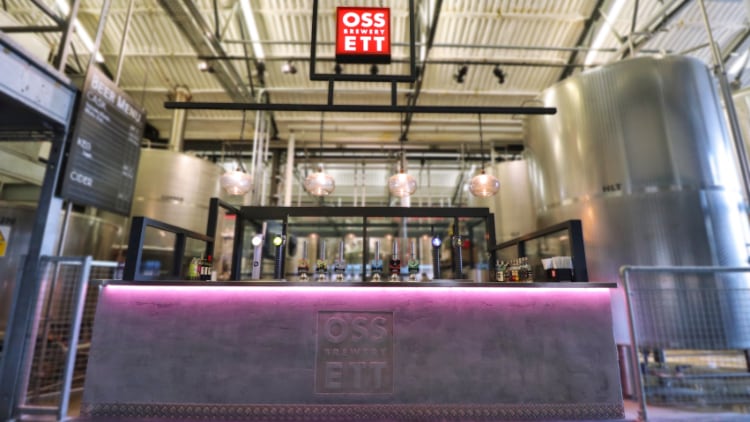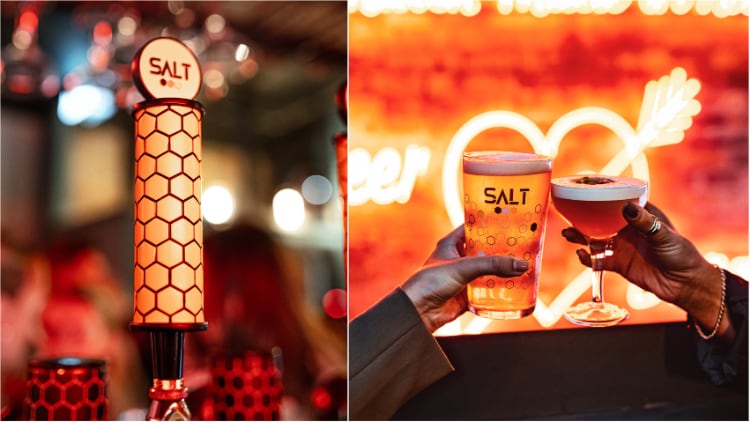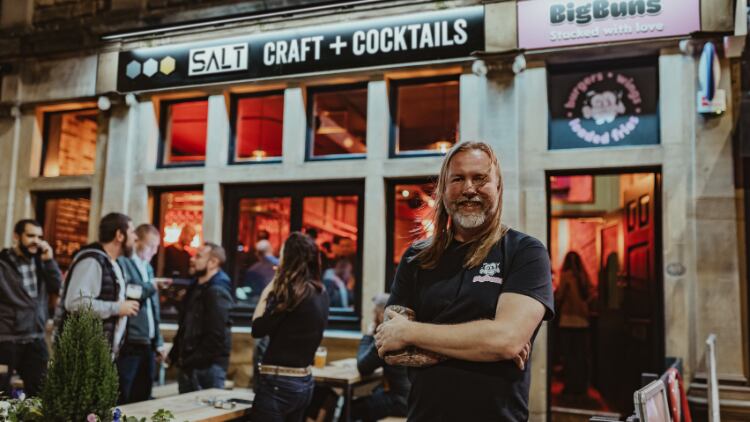Many hospitality sites turned their hand to providing food cupboard essentials for those who couldn’t get to shops and great meals for those who wanted to share the taste, if not quite the atmosphere, of the pub.
However, Jamie Lawson, owner of cask beer producer and pub operator Ossett Brewery realised about five years before Covid struck that craft beer was making inroads into the on and off-trades and it was time to get on board.
That craft kegged business is going great guns now with new taprooms opening at speed and off-trade listings galore under the Salt Beer Factory moniker.
Lawson says: “The story behind Salt is we’ve been brewing cask beer for the best part of 20 years but in 2015 I had this idea we needed to brew, alongside the cask beers, a more modern style of beer, so the likes of BrewDog and Magic Rock were inspirations to me to want to do something else as well as the great cask beers we brew.
“I can reel off a number of SIBA national awards and national champion awards that our beers have won and I’m very proud of our heritage at Ossett but we felt we’d left it too long to use the Ossett brand to lead a new start, which would be brewing craft beers as a brand that was very much entrenched as a cask ale brewer.
“We felt we needed a fresh start and it was always going to be in a separate site with a separate team, so there was that independence from a brewing perspective. Yeah, I suppose we thought we’d missed the boat as Ossett so that’s why we formulated a new company.”
The pub company was always independent to the brewery but the two things worked hand in hand.”
The whole process from the incubation of the idea in 2015 to the first Salt brew in 2018 took about three years – with IT business expert Mark Hunter investing in the company in 2019 to become 50:50 co-owner with Lawson.
Setting up the pubco
However, Lawson’s first involvement with the family business began in the late ’90s. He explains: “Ossett Brewery was started in 1998 by my father and his business partner. I was living in Japan at the time and working for a Japanese bank. I’m not really good at banking but I do speak fluent Japanese. I came back from Tokyo in 2002 and, after a brief spell in the brewery, I set up a pub company essentially selling Ossett Brewery beer.
“It was a separate company, independently financed. I set up our first pub as an independent company and the pubco grew at quite a rate and we’ve now got, in Ossett and Salt, 34 sites – it breaks down to 25 Ossett and nine Salt.
“The 25 Ossett sites sprang up quite quickly in the early days. By 2007/2008, we had 10 pubs. From a shareholding perspective, I became sole owner [of the brewery and pub estate] in about 2016 but the pub company was always independent to the brewery but the two things worked hand in hand in terms of the strong brand of the brewery helping the pubs and the increased sales of the beer at the pubs helped the brewery.”

All the Ossett pub sites are in the north (with the brewery being in Ossett, which is between Wakefield and Dewsbury) and Salt sites are located mostly in the north of England with two in London.
Only one beer run for Salt is made at the Ossett brewery and that is a packaged version of a single beer. Salt has two brewery sites with the original – Salt Beer Factory North – being based in the Unesco village of Saltaire.
“That is very much a kind of interactive brewery space,” Lawson says. “We won Best UK taproom at the SIBA awards in 2020 and we got into the world finals of the SBID (Society of British and International Interior Designers) Interior Design Awards, which is a global design body in the bar and club category.
“From a visual and sales perspective, it’s the site we’re most proud of. It’s a bar-restaurant-brewery-taproom where you can almost reach out and touch the vessels. There’s quite a sizable kit in there where the brewery shares equal parity with the retail. It has some different mezzanines where you can overlook the brewery – it’s quite a spectacular place to visit.”
He adds the main difference between Ossett and Salt is that Ossett is primarily a cask ale brewery and always has been since its foundation in 1998 while Salt is a kegged and can brewery.
The core range at Ossett comprises Butterley at 3.8% ABV, Yorkshire Blonde at 3.9% ABV, White Rat at 4.1% ABV, Silver King at 4.3% ABV, Voodoo at 5% ABV and Excelsius at 5.2% ABV. In addition, there are two specials a month and one of those is a collaboration brew with another brewery. Ossett has a calendar of monthly collabs with differing partner brewers. Recent pairings have been with Thornbridge, JW Lees and Brew York with Beartown is coming up soon.
About a quarter of the cask beer Ossett produces goes into its own estate and the rest is sold into the free trade.
Modern-style brewery
Craft kegged beer brewer Salt is based in Unesco World Heritage village Saltaire, which is just north of Bradford. Lawson says: “We’re in a Grade II-listed building so we had to jump through hoops to get where we needed to be to start it in 2015. We then embarked upon raising the finance for it. I had all the interactions with the listed building conservation department and Bradford Council, along with Unesco – they were all very supportive but these things take a long time and I think it was about a year and a half for the different planning permissions and conservation permissions.
“The idea was to create a space that combined brewing and retail but gave equal parity for both. It was the advent of the American-style brewpub where you go to the brewery, there’s a taproom and you very much feel part of the brewing environment. The brewery is a big open-plan space of 8,000sq ft with the brewery being completely on the show then there’s mezzanines on top of that and it’s got a full kitchen, a wraparound horseshoe bar, separate taproom, viewing mezzanines and we’ve got gaming like shuffleboard in there.
“We’ve got DJ booth too so it’s a bit of a chameleon venue – we get older clientele in the daytime for coffees and sandwiches at lunchtimes and on a Friday or Saturday, a DJ comes on and it morphs into a more upbeat local club vibe so multifaceted in that sense and is a venue we’re very proud of.”

Salt’s beers are commonplace at supermarkets with approximately a quarter of the brewer’s trade being with the likes of Tesco, Asda, Morrison’s and Sainsbury’s stocking its craft cans. Despite a small amount of online trade, Salts beers hit the shelves of Tesco in March 2020 – a fact Lawson describes as “somebody shining down on us and we got we got lucky”. Subsequently, its first beer there, Ikat – a double IPA at 8% ABV – was a hit when pubs were not allowed to open.
He adds: “That was obviously a big boost for us during the lean Covid lockdown times but then we were approached by Molson Coors, who we have been a customer of for many years, buying the likes of Coors and Carling for our more traditional Ossett sites, towards the back end of Covid with an idea to do a trial for distributing the Salt beers within the northern region of their network.
“We were very grateful for the approach they made to us and the trial went well so we have now rolled out nationally with three of our core Salt beers. Loom at 4% ABV, Jute at 4.2% ABV and Huckaback at 5.5%% ABV are now distributed nationally by Molson Coors to the on-trade.
“We’ve popped up in various places through that distribution such as Junkyard Golf, cricket-themed Sixes and Molineux stadium where Wolverhampton Wanderers play football.”
Cask in growth
On the subject on how to reinvigorate the cask category that suffered more than most during Covid naturally because cask’s perfect environment is at the pub and can’t be recreated at home, Lawson says: “I’m a big cask fan, that’s how I got into the business and absolutely love cask beer. When cask is on form and kept well, it’s the best format to drink beer.
“We’re bucking the trend at Ossett because we’re in growth so although you read these, kind of, CGA data reports about cask, as a category, falling, a lot of the falls are in some of the big national brands. And because of the size of those falls, it disproportionately makes the sector look as though it’s performing really poorly but there are pockets within cask where there are certain breweries bucking the trend. We’ve been in growth for the past couple of years, coming out of Covid.”
For cask to attract younger drinkers, it almost has to learn from the craft keg model that it can’t be stuck in its ways – it needs to be inventive.”
He adds there are other aspects that contribute to the issue such as a lot of the big brewers tending to rely on a single big brand. “It’s not always ‘brown’ but in many cases it is,” Lawson says. “While I still believe traditional brown bitter has its place, a business can’t just be a one trick pony because you need more strings to your bow in terms of being able to follow trends more quickly and more adeptly.”
It is key to Lawson that a beer producer adds trends into its brewing schedule because being versatile is essential because cask now has to look what’s happening in the craft keg market where there’s collaborations and new styles of beer coming out almost on a monthly basis.
“Beer consumers expect that variety and that frequency of change,” Lawson says. “For cask to attract younger drinkers, it almost has to learn from the craft keg model that it can’t be stuck in its ways and do the same thing time and time again, it needs to be inventive, it needs to be creative and we’ve been successful in doing that at Ossett.
“It also helps that Salt bars will sell some of the cask and the more traditional pubs will sell some Salt keg so there’s a nice overlap there.”
Taproom openings
Last week, Salt opened its a new taproom in Oakwood, Roundhay, north Leeds, which is its eighth site and is called Salt Oakwood. However, there is a ninth due to open under the moniker Calls Landing, set in The Calls, Leeds, in December 2022. Plus, there’s plans for five Salt openings in 2023.
On the speedy openings, Lawson says his area of involvement in the business over the past 20 years has been on the retail side, which has led to the business buying a number of freeholds as rundown or dilapidated and then refurbished.

“The longer you do it, the easier it gets so it almost felt like the obvious thing to do when we started a new brand of Salt,” he says. “That’s what spurned the first taproom outside of the brewery. It went well and we’ve got irons in the fire for another five sites next year.
“They’re a slightly different vibe to Ossett pubs, which tends to be real fires, stone floors, more traditional buildings with a modern twist on the interior decor. Essentially, they are kind of more traditional boozers while Salt tends to be more city centre or suburban sites where they’ve got more of a city centre feel but still with traditional elements in there such as exposed brickwork, floorboards, but with more of a city centre appeal and we use neon and an industrial feel to the interior décor.”
He says sites offer a range of Salt beers, guest beers, draught cocktails and wines from its own wholesaling company called Barrique Fine Wines, which is run with sommelier Ed Simpson. Salt taprooms partner with a local food operator so there’s a different concept in each of the sites with Falafel Guys at Salt Granary Wharf, Bao Mesters at Salt Sheffield and BigBuns (a smashed burgers menu) at Salt Oakwood.




